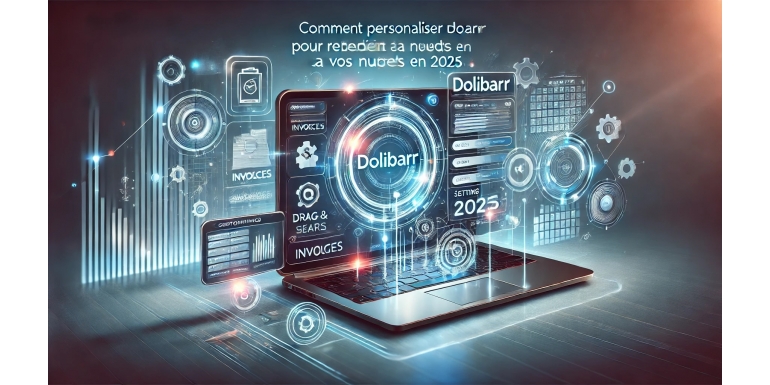
In 2025, Dolibarr has established itself as one of the most powerful and accessible open-source ERP/CRM solutions. With its modular design and active ecosystem, it can be deployed in a wide range of contexts: small and medium enterprises, nonprofits, freelancers, and even large organizations. However, to fully leverage this platform, it is often essential to customize Dolibarr so it aligns with your specific requirements. In this article, we will explore how to customize Dolibarr in 2025, from the initial setup to advanced extensions, as well as how to modify the interface and processes.
1. Why Customize Dolibarr?
1.1. Boost Efficiency
Dolibarr stands out for its ease of use and flexibility. Yet every organization has unique needs in terms of data management, workflows, or reporting. Customizing Dolibarr allows you to:
- Reduce the time spent searching for information
- Automate certain tasks or workflows
- Centralize key indicators (KPIs) for better visibility
1.2. Strengthen User Adoption
The default Dolibarr interface may require adjustments to align with the visual culture or internal organization of your company. A more tailored tool—aligned with work habits and company aesthetics—improves user engagement and buy-in.
1.3. Stand Out in a Competitive Environment
In 2025, ERPs are increasingly widespread. Customizing Dolibarr allows you to offer a unique user experience, whether it involves modules dedicated to a particular sector (retail, finance, e-commerce) or specialized features designed to optimize your processes.
2. Initial Configuration and Basic Settings
2.1. Enable Relevant Modules
Dolibarr relies on a system of modules. To avoid overloading the interface and impacting performance, activate only the modules you need (CRM, Billing, Inventory, Projects, HR, etc.). Go to Configuration > Modules to check or uncheck the ones that apply to your business.
2.2. Personalize the Appearance
- Logo and Branding: Include your company’s logo and adjust the main colors to reflect your brand identity.
- Themes and Templates: Several themes are available by default or via extensions. Choose one that enhances readability and matches your company’s style.
2.3. Define Regional Settings
- Currency and Tax Rates: Make sure to select the right currency (or multiple) and configure tax/VAT rates for your country.
- Date Format and Language: Dolibarr supports various languages and date formats, facilitating use in multinational contexts.
3. Adapting the User Interface
3.1. Customize Menus
- Rearrange Tabs: Dolibarr lets you move or rename certain menus to make essential features more accessible.
- Icons and Labels: Select meaningful icons for each module and rename labels according to the terms used internally.
3.2. Simplify the User Experience
- Hide Unnecessary Fields: Some default fields may not always be relevant. You can disable them to avoid cluttering the interface and enhance employee productivity.
- Kanban Views and Dashboards: Some modules or extensions offer more visual interfaces (e.g., Kanban view for projects, dynamic dashboards) to better prioritize tasks.
3.3. Mobile Integration
In 2025, mobility is central to everyday use:
- Mobile Apps: Official or third-party iOS and Android apps provide easy access to Dolibarr on the go.
- Responsive Design: Make sure your chosen theme or configuration adapts well to tablets and smartphones.
4. Automation and Custom Workflows
4.1. Automatic Rules and Triggers
Dolibarr allows you to set conditional rules (triggers) to perform actions when certain events occur:
- Automatically create an invoice upon order validation
- Send follow-up emails for overdue invoices beyond a specified date
- Update a field automatically when a project’s status changes
4.2. Scripts and API
- Custom Scripts: PHP scripts can extend Dolibarr or automate complex tasks.
- REST API: Dolibarr provides an API that enables integration with other systems (external accounting, e-commerce site, internal applications). This way, you can create cross-tool workflows to streamline processes.
5. Extensions and Additional Modules
5.1. Selecting Key Extensions
- Advanced Invoicing: To create more sophisticated invoice templates.
- E-commerce Modules: Integration with Prestashop, WooCommerce, etc.
- Cloud Connectors: To automatically back up data on services like Dropbox, OneDrive, etc.
5.2. Marketplace and Community
- Online Marketplace: Specialized sites such as NextGestion offer certified modules or themes.
- Collaborative Support: On Dolibarr forums, the community shares tips, fixes, and feedback to help you choose and configure the right modules.
6. Security and Advanced Settings
6.1. Managing Access Rights
To protect your data:
- Roles and Permissions: Create profiles (e.g., sales, accounting) and assign the rights that match each user’s requirements.
- Multi-Factor Authentication: Add an additional security layer beyond passwords (mobile app, SMS, etc.).
6.2. Encryption and Backups
- HTTPS (SSL/TLS): Enforce secure connections for all users.
- Scheduled Backups: Configure regular backups, preferably stored on external or cloud media.
6.3. Updates and Patches
Dolibarr evolves regularly:
- Updating Dolibarr: You benefit from the latest features and security patches.
- Updating Modules: Check for compatibility and possible conflicts when applying updates.
7. Feedback and Practical Advice
- Train Your Team: Effective customization is futile if users don’t know how to use it. Targeted training increases adoption of new workflows.
- Document Your Configuration: Note your customization choices (activated modules, installed scripts) to facilitate maintenance or handover.
- Start Small, Evolve Iteratively: Dolibarr supports an agile approach. First enable a few essential features, then add more as new needs arise.
Conclusion
Customizing Dolibarr in 2025 is essential for fully leveraging this open-source ERP/CRM to meet the unique demands of each organization. Whether it’s about revising the interface, automating key processes, or integrating advanced modules, numerous options are supported by a dynamic community. With some planning and a solid understanding of your company’s needs, you can transform Dolibarr into a powerful, user-friendly tool perfectly aligned with your operations.
Don’t wait any longer: embark on customizing Dolibarr and discover how it can become a true competitive advantage and growth driver, suited to the challenges of 2025!
